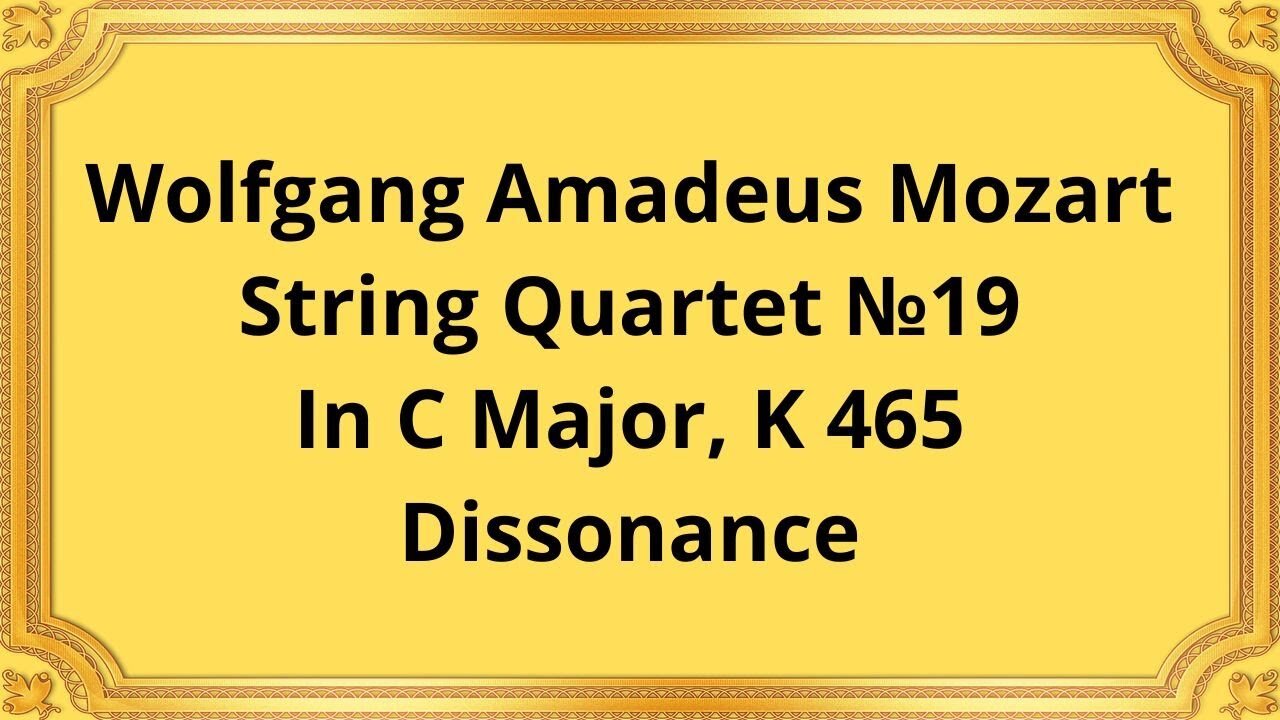Premium Only Content

Wolfgang Amadeus Mozart String Quartet №19 In C Major, K 465 Dissonance
#WolfgangAmadeusMozart #StringQuartet #No19 #CMajor #K465 #Dissonance #ClassicalMusic #ChamberMusic #ClassicalComposer #MusicalComposition
THE AEOLIAN STRING QUARTET (Sydney Humphreys,
1st violin; Trevor Williams, 2nd violin; Watson Forbes, viola;
Derek Simpson, cello)
The Wolfgang Amadeus Mozart String Quartet No. 19 In C Major, K 465, also known as the Dissonance Quartet, is a remarkable musical composition that showcases Mozart's genius and innovative spirit. Composed in the late 18th century, this string quartet stands out for its exploration of dissonance, harmonic complexity, and emotional depth.
Wolfgang Amadeus Mozart composed the String Quartet No. 19 in 1785 during a period of great artistic exploration and musical development. Mozart was a prominent figure of the Classical era, known for his prodigious talent and ability to push the boundaries of musical conventions. The Dissonance Quartet was composed at a time when Mozart was experimenting with new harmonic ideas and expanding the possibilities of chamber music.
The String Quartet No. 19 in C Major, K 465 consists of four movements, each displaying Mozart's mastery of form, melody, and harmonic innovation.
1. Adagio - Allegro: The first movement begins with an extended and dissonant introduction, earning the quartet its nickname. The dissonances create a sense of tension and anticipation that is beautifully resolved in the lively Allegro section. Mozart expertly combines melodic richness with intricate contrapuntal writing, showcasing his ability to balance complexity and clarity.
2. Andante cantabile: The second movement is a serene and lyrical exploration of melody. The quartet members engage in a musical conversation, passing the melodic themes between instruments. Mozart's gift for creating expressive and memorable melodies is on full display in this movement.
3. Menuetto: Allegro: The third movement is a lively and rhythmic minuet. Mozart combines elegance and playfulness, with contrasting sections that showcase the quartet's technical virtuosity. The movement is characterized by its rhythmic drive and melodic charm.
4. Allegro molto: The final movement is a tour de force of musical energy and complexity. It features rapid passages, intricate counterpoint, and bold harmonic progressions. Mozart demonstrates his ability to create tension and release, engaging the listener until the exhilarating conclusion.
The Dissonance Quartet has had a profound impact on the world of classical music. Mozart's daring use of dissonance and harmonic complexity challenged the conventions of his time and paved the way for future composers to explore new musical territories. The quartet inspired subsequent generations of composers, including Ludwig van Beethoven and Franz Schubert, who were influenced by Mozart's innovative approach to chamber music.
Conclusion:
The Wolfgang Amadeus Mozart String Quartet No. 19 In C Major, K 465 Dissonance stands as a testament to Mozart's musical genius and his willingness to push the boundaries of musical expression. Through its exploration of dissonance, harmonic complexity, and emotional depth, this quartet has left an indelible mark on the world of classical music. Mozart's ability to balance innovation with beauty and clarity is evident in every movement, creating a timeless masterpiece that continues to captivate audiences today. The Dissonance Quartet serves as a reminder of the power of musical innovation and the enduring legacy of Wolfgang Amadeus Mozart.
You have the opportunity to support the channel:
https://destream.net/live/RadSiarAl/donate
https://www.buymeacoffee.com/6355radsiaral
-
 31:06
31:06
Classical music_Music Inspiration
22 days agoPyotr Ilyich Tchaikovsky Piano Concerto No. 1 in B-flat minor
531 -
 6:34:50
6:34:50
SpartakusLIVE
11 hours ago#1 Saturday Spartoons on RUMBLE PREMIUM
113K7 -
 1:04:59
1:04:59
Man in America
12 hours ago“Summoning the Demon” — The AI Agenda Is FAR WORSE Than We Know w/ Kay Rubacek
50.5K36 -
 2:16:48
2:16:48
Tundra Tactical
10 hours ago $0.11 earned🎯💥 The World’s Okayest Gun Show 🔫😂 | LIVE Tonight on Rumble!
31.3K1 -
 3:36:03
3:36:03
Mally_Mouse
1 day ago🌶️ 🥵Spicy BITE Saturday!! 🥵🌶️- Let's Play: Tower Unite!
57.1K2 -
 58:59
58:59
MattMorseTV
10 hours ago $1.61 earned🔴Trump just BROKE Newsom.🔴
73.1K85 -
 18:14
18:14
Her Patriot Voice
10 hours agoWho Is WORSE for NYC: Trump Girl or Socialist?
55K34 -
 3:39:42
3:39:42
SavageJayGatsby
10 hours agoSpicy Saturday with Mally! | Road to 100 | $300 Weekly Goal for Spicy Bites!
51.7K1 -
 3:35:50
3:35:50
FomoTV
12 hours ago🚨 Swamp Theater: FBI Raids Bolton 🕵 Still NO Epstein Files, Trump's Troops & the Red Heifer Hoax 🐂 | Fomocast 08.23.25
23.9K7 -
 6:04:40
6:04:40
Akademiks
15 hours agoRoc Nation & Meg Thee Stallion did a 7 HOUR Deposition with me. Drake Secret Kid Finally Revealed.
60K3